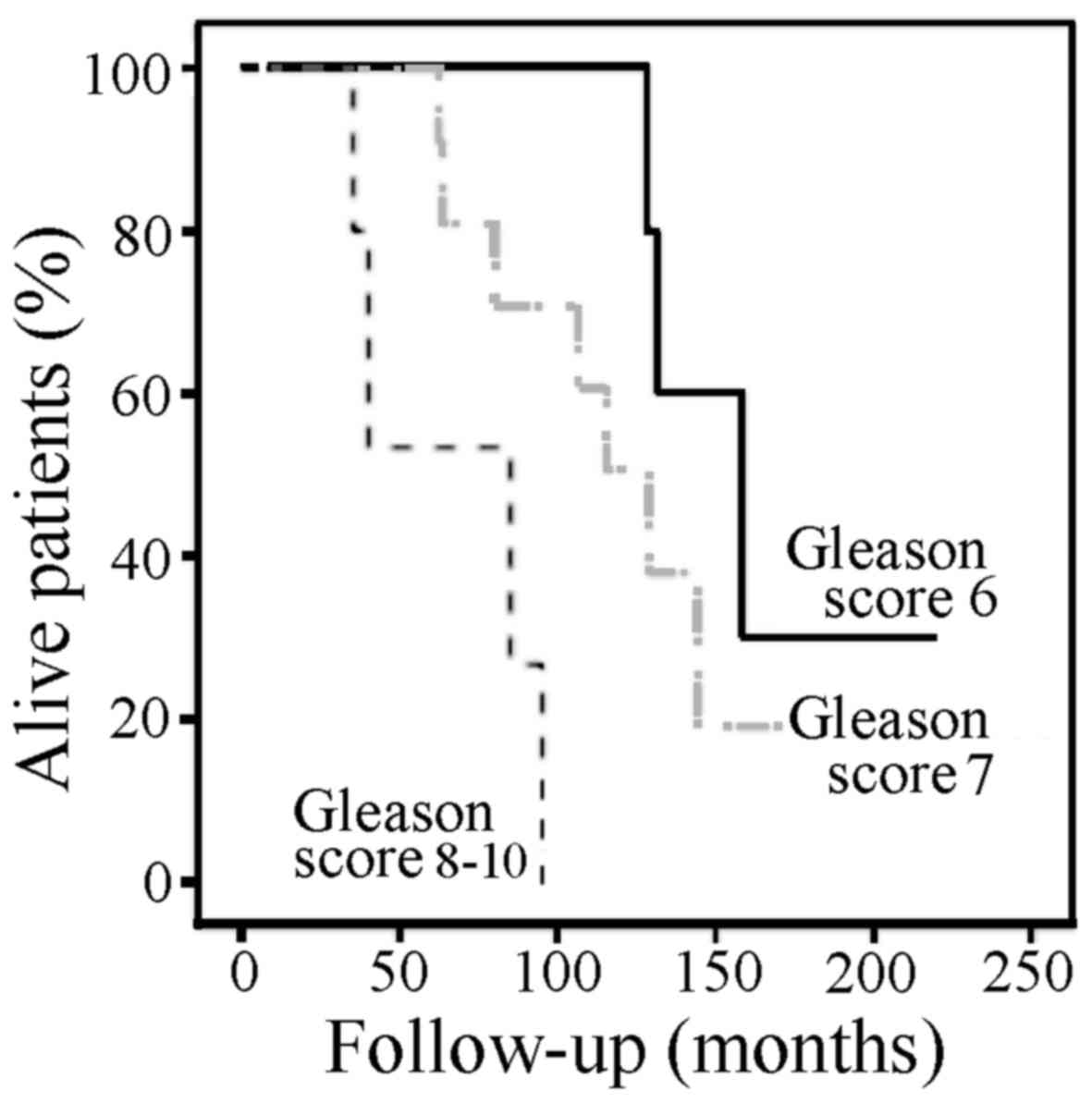|
1
|
Prostate (PRC) cancer factsheet.
http://www.encr.eu/images/docs/factsheets/ENCR_Factsheet_Prostate_2014.pdfAccessed.
September 28–2016.
|
|
2
|
Wilt TJ, MacDonald R, Rutks I, Shamliyan
TA, Taylor BC and Kane RL: Systematic review: Comparative
effectiveness and harms of treatments for clinically localized
prostate cancer. Ann Intern Med. 148:435–448. 2008. View Article : Google Scholar : PubMed/NCBI
|
|
3
|
Hamdy FC, Donovan JL, Lane JA, Mason M,
Metcalfe C, Holding P, Davis M, Peters TJ, Turner EL, Martin RM, et
al: Study Group: 10-Year Outcomes after Monitoring, Surgery, or
Radiotherapy for Localized Prostate Cancer. N Engl J Med. Epub
ahead of print. https://doi.org/10.1056/NEJMoa1606220
|
|
4
|
Guideline for the management of clinically
localized prostate cancer. 2007.https://www.auanet.org/education/guidelines/prostate-cancer.cfmAccessed
September 28, 2016.
|
|
5
|
Kawakami J, Cowan JE, Elkin EP, Latini DM,
DuChane J and Carroll PR: CaPSURE Investigators:
Androgen-deprivation therapy as primary treatment for localized
prostate cancer: Data from Cancer of the Prostate Strategic
Urologic Research Endeavor (CaPSURE). Cancer. 106:1708–1714. 2006.
View Article : Google Scholar : PubMed/NCBI
|
|
6
|
Tammela T: Endocrine treatment of prostate
cancer. J Steroid Biochem Mol Biol. 92:287–295. 2004. View Article : Google Scholar : PubMed/NCBI
|
|
7
|
Smith MR, Kabbinavar F, Saad F, Hussain A,
Gittelman MC, Bilhartz DL, Wynne C, Murray R, Zinner NR, Schulman
C, et al: Natural history of rising serum prostate-specific antigen
in men with castrate nonmetastatic prostate cancer. J Clin Oncol.
23:2918–2925. 2005. View Article : Google Scholar : PubMed/NCBI
|
|
8
|
Dotan ZA, Bianco FJ Jr, Rabbani F, Eastham
JA, Fearn P, Scher HI, Kelly KW, Chen HN, Schöder H, Hricak H, et
al: Pattern of prostate-specific antigen (PSA) failure dictates the
probability of a positive bone scan in patients with an increasing
PSA after radical prostatectomy. J Clin Oncol. 23:1962–1968. 2005.
View Article : Google Scholar : PubMed/NCBI
|
|
9
|
Lankford SP, Pollack A and Zagars GK:
Radiotherapy for regionally localized hormone refractory prostate
cancer. Int J Radiat Oncol Biol Phys. 33:907–912. 1995. View Article : Google Scholar : PubMed/NCBI
|
|
10
|
Furuya Y, Akakura K, Akimoto S, Ichikawa T
and Ito H: Radiotherapy for local progression in patients with
hormone-refractory prostate cancer. Int J Urol. 6:187–191. 1999.
View Article : Google Scholar : PubMed/NCBI
|
|
11
|
Akimoto T, Kitamoto Y, Saito J, Harashima
K, Nakano T, Ito K, Yamamoto T, Kurokawa K, Yamanaka H, Takahashi
M, et al: External beam radiotherapy for clinically node-negative,
localized hormone-refractory prostate cancer: Impact of
pretreatment PSA value on radiotherapeutic outcomes. Int J Radiat
Oncol Biol Phys. 59:372–379. 2004. View Article : Google Scholar : PubMed/NCBI
|
|
12
|
Sasaki T, Nakamura K, Ogawa K, Onishi H,
Okamoto A, Koizumi M, Shioyama Y, Mitsumori M and Teshima T:
Japanese Patterns of Care Study Working Subgroup on Prostate
Cancer: Radiotherapy for patients with localized hormone-refractory
prostate cancer: Results of the Patterns of Care Study in Japan.
BJU Int. 104:1462–1466. 2009. View Article : Google Scholar : PubMed/NCBI
|
|
13
|
Sanguineti G, Marcenaro M, Franzone P,
Tognoni P, Barra S and Vitale V: Is there a “curative” role of
radiotherapy for clinically localized hormone refractory prostate
cancer? Am J Clin Oncol. 27:264–268. 2004. View Article : Google Scholar : PubMed/NCBI
|
|
14
|
Nakamura K, Teshima T, Takahashi Y, Imai
A, Koizumi M, Mitsuhashi N, Shioyama Y and Inoue T: Japanese PCS
Working Subgroup of Prostate Cancer: Radiotherapy for localized
hormone-refractory prostate cancer in Japan. Anticancer Res.
24:3141–3145. 2004.PubMed/NCBI
|
|
15
|
Gogna NK, Baxi S, Hickey B, Baumann K,
Burmeister E and Holt T: Split-course, high-dose palliative pelvic
radiotherapy for locally progressive hormone-refractory prostate
cancer. Int J Radiat Oncol Biol Phys. 83:e205–e211. 2012.
View Article : Google Scholar : PubMed/NCBI
|
|
16
|
White R, Khor R, Bressel M, Duchesne G,
Williams S, Bowden P, Tai K and Foroudi F: Efficacy of high-dose
palliative radiotherapy for localised, castration-resistant
prostate cancer. Clin Oncol (R Coll Radiol). 27:16–21. 2015.
View Article : Google Scholar : PubMed/NCBI
|
|
17
|
Sobin L and Wittekind C: Union for
international cancer control: TNM classification of malignant
tumours. 6th. Wiley; New York: 2002
|
|
18
|
Heidenreich A, Bastian PJ, Bellmunt J,
Bolla M, Joniau S, van der Kwast T, Mason M, Matveev V, Wiegel T,
Zattoni F, et al: European Association of Urology: EAU guidelines
on prostate cancer. Part II: Treatment of advanced, relapsing, and
castration-resistant prostate cancer. Eur Urol. 65:467–479. 2014.
View Article : Google Scholar : PubMed/NCBI
|
|
19
|
Bosco C, Bosnyak Z, Malmberg A, Adolfsson
J, Keating NL and Van Hemelrijck M: Quantifying observational
evidence for risk of fatal and nonfatal cardiovascular disease
following androgen deprivation therapy for prostate cancer: A
meta-analysis. Eur Urol. 68:386–396. 2015. View Article : Google Scholar : PubMed/NCBI
|
|
20
|
Botticella A, Guarneri A, Filippi AR,
Levra NG, Munoz F, Ragona R, Gontero P and Ricardi U: May
non-metastatic clinically localized castration-resistant prostate
cancer after primary androgen ablation benefit from salvage
prostate radiotherapy? J Cancer Res Clin Oncol. 139:1955–1960.
2013. View Article : Google Scholar : PubMed/NCBI
|
|
21
|
Ogawa K, Nakamura K, Sasaki T, Onishi H,
Koizumi M, Shioyama Y, Araya M, Mukumoto N, Mitsumori M and Teshima
T: Japanese Patterns of Care Study Working Subgroup of Prostate
Cancer: External beam radiotherapy for clinically localized
hormone-refractory prostate cancer: Clinical significance of Nadir
prostate-specific antigen value within 12 months. Int J Radiat
Oncol Biol Phys. 74:759–765. 2009. View Article : Google Scholar : PubMed/NCBI
|










